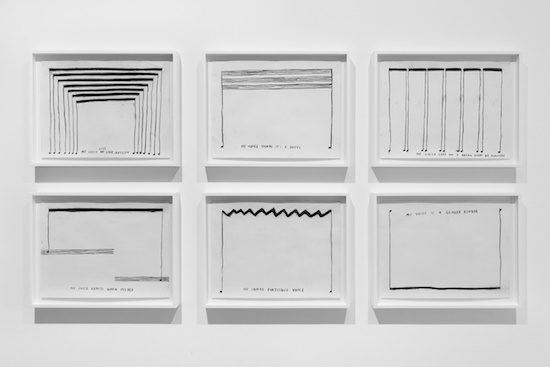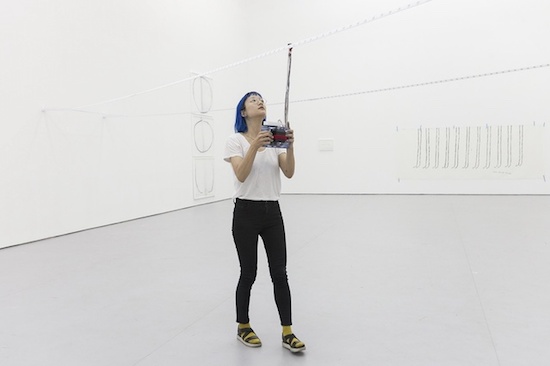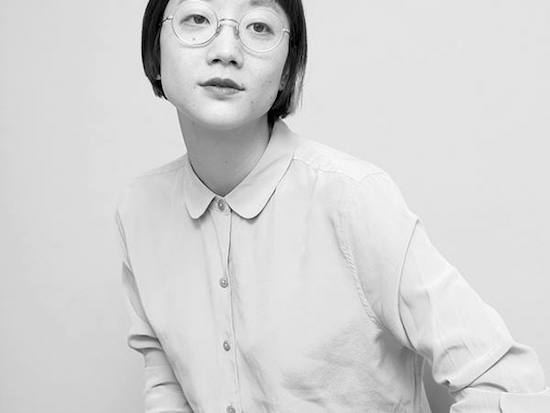At Christine Sun Kim’s solo exhibition at Carroll/Fletcher last year, the first gallery was dominated by a peculiar-looking set-up. Game of Skill 1.0 transformed visitors into what the artist calls “a human turntable” where “you are the needle”. Clutching hold of a plastic device, people would walk around a wire track suspended from the ceiling, trying to keep the device’s antenna attached to the magnetic strip on the track. “As you walk,” she explains, “there is audio that has already been programmed inside of the device, and if you’re hitting the magnetic strip at a decent interval, you’ll be able to hear audio. So as you go forward, you’ll be able to hear forward, and if you walk backward, it’s going to go backwards.”
Game of Skill is typical of Kim’s work inasmuch as it immediately problematises what, for most people, is an entirely unproblematic – and hence, unthought – experience: hearing. Deaf since birth, Kim began working with sound “because I was fascinated by the way people responded and reacted and used sound in their everyday life. And I think often hearing individuals take for granted everything they have access to. You can go into a restaurant and overhear the couple next to you talking about whatever it is they’re talking about. If you’re on the metro or the subway, you can hear announcement where the train conductor is saying we’re going to be stopped for a while.”
We spoke via Skype, on a three-way connection with interpreter Dylan Geil. Three time zones in one (virtual) space. As we chatted, I became aware how contingent and situated our experience of sound is. Part of what makes Kim’s work important is that it has the power to upend the seeming self-evidence of so much nineteenth and twentieth century thinking about sound. What had been presented as universal truth is suddenly exposed as the particular experience of a privileged group. Like the participants in Game of Skill, Kim’s sound work is a precarious navigation towards new kinds of thinking, openness, and empathy.
“When I started playing with sound,” she says, “and introducing it into my art work, I had to find the right question, I had to find the right delving point. I think I started with the wrong question at first. I focused more on a narrow niche of sound and how it applied to me or the deaf community. I was trying to make aesthetic and conceptual questions based on the wrong question. If I used other individuals’ idea of sound and tried to apply that to my work, the result was not right because I felt that I had no ownership of that project itself.
“There’s actually a video from The Selby of my work from 2012, a process called Visualise Sound. I have different ink prints and I had used loudspeakers to make these ink prints with various objects that I just put paint on.
Christine Sun Kim, A Selby Film from the selby on Vimeo.
"The moment when I started doing that, many individuals reached out to me to become collaborators, saying things like please use my sound. I want you do your work with my music, with my voice when you do this. I kind of thought, okay. It’s a little bit of a strange a request to receive because I felt a little bit like it wouldn’t be my art work, that other people were trying to infringe on my artistic decision-making. So it took a lot of time for me to be comfortable working with collaborators and yet still feel ownership of the pieces we produce.
“So I guess there are three things that helped me a lot. One is realising that sound has social currency and is extremely powerful in today’s day and age. The second is that sound is expensive. Sound feels very expensive to me. And the third is that sound requires a lot of trust on my part. Because the idea that I have to grapple with everyday is that I give up my own voice to get voice. I rely on the mediation of an interpreter or an electronic device to be able to then take ownership of my voice.”

One of the things that’s interesting about your work is that it makes apparent certain things that actually are true for everyone – sound is always mediated, it is always physical – it is always being mediated by the radio or the TV or the air between us, but most people don’t think of it this way, the way this affects the way we receive sound.
I visualise sound and I look at people’s responses and reactions. Hearing people to me have always kind of been my speakers. I rely on them to then react myself to that information. Deaf people know sound very well. Often people think we don’t – and even the deaf community thinks we don’t know sound very well. It’s strange to be in our position where we almost impose the barrier on ourselves to some degree. Again, it could also be coming from external sources. But I decided that with my work, I wanted to change the dialogue and remove that outsider’s perspective that has been placed on us, to reclaim my ownership of sound.
A lot of your drawings play with the form of music notation. What is about music notation that appeals to you?
When I started using sound in my artwork, somebody told me that I should look at American Sign Language glossing. It’s a very rudimentary system for coding ASL on paper because American Sign Language doesn’t have a written system like other spoken languages do. It’s a very rudimentary system that allows us to text back and forth, and linguists use it for documentation. I started thinking about a graphic score. I thought, well, they’re kind of similar. So I was wondering if glossing was equivalent to a visual score and I started playing around with that idea. I was also trying to figure out how we might use the same system to notate American Sign Language and music at the same time. American Sign Language and music – at least in terms of notation – are typically closed doors. They’re hard for people to access without a lot of work. You either learn musical notation, grow up with it, take classes – and it’s the same with American Sign Language. It’s something people feel is inaccessible. But I feel if we could harness the power that both music and American Sign Language have and give them equal space in society, that could open the door for more people to experience both, which is kind of why I gravitated towards using visual scores. I view them as works that have man connections to the community at large, whether you be deaf or hearing.

In recent years, I’ve noticed a significant change in the way composers think about silence. For John Cage, silence was still something to listen to. Silence, for Cage, meant unintentional sound and he was fascinated with listening closely to these “silent” sounds. I think because Cage was so influential, a lot of musicians and composers followed him in asking us to listen to the space “between the notes,” as it were. But recently I’ve started seeing new approaches to silence, more abstract, more conceptual, less phenomenal.
I agree fully. I think people are wanting to disassociate with the school of Cage, in terms of silence. One thing I enjoy about Cage is he did break all the rules of music and that’s something very noteworthy. In terms of his concept of silence and time, I think that was groundbreaking. Do you know the story about Cage going to a room in Boston –
The anechoic chamber at Harvard.
Yes, that’s right. And he said he could hear his heart beating. People were thinking that was so groundbreaking. I wanted to say, I’ve had that experience my whole entire life – and other deaf people have too. But, you know, John Cage said it first so he gets the credit. I couldn’t help thinking, what are you talking about? This isn’t new, this isn’t groundbreaking! People have this experience every day! I think it’s interesting how you process data first. Do you process it visually, do you process it auditorily, do you process it tactually? Depending on your orientation to the world, you’ll have new insights.
Christine Sun Kim performs at Kammer Klang, Cafe Oto, on Tuesday 7 February


